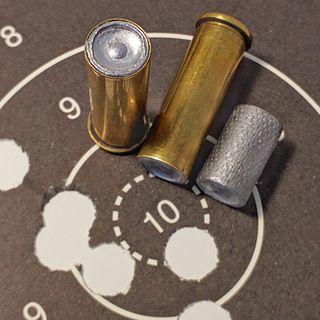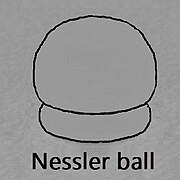
A rifle is a long-barreled firearm designed for accurate shooting and higher stopping power, with a barrel that has a helical pattern of grooves (rifling) cut into the bore wall. In keeping with their focus on accuracy, rifles are typically designed to be held with both hands and braced firmly against the shooter's shoulder via a buttstock for stability during shooting. Rifles are used extensively in warfare, law enforcement, hunting, shooting sports and crime.

A bullet is a kinetic projectile, a component of firearm ammunition that is shot from a gun barrel. They are made of a variety of materials, such as copper, lead, steel, polymer, rubber and even wax; and are made in various shapes and constructions, including specialized functions such as hunting, target shooting, training, and combat. Bullets are often tapered, making them more aerodynamic. Bullet size is expressed by weight and diameter in both imperial and metric measurement systems. Bullets do not normally contain explosives but strike or damage the intended target by transferring kinetic energy upon impact and penetration.
A muzzleloader is any firearm, in which the user loads the projectile and the propellant charge into the muzzle end of the gun. This is distinct from the modern designs of breech-loading firearms, in which user loads the ammunition into the breech end of the barrel. The term "muzzleloader" applies to both rifled and smoothbore type muzzleloaders, and may also refer to the marksman who specializes in the shooting of such firearms. The firing methods, paraphernalia and mechanism further divide both categories as do caliber.

Rifling is the term for helical grooves machined into the internal surface of a firearms's barrel for imparting a spin to a projectile to improve its aerodynamic stability and accuracy. It is also the term for creating such grooves.

A musket is a muzzle-loaded long gun that appeared as a smoothbore weapon in the early 16th century, at first as a heavier variant of the arquebus, capable of penetrating plate armour. By the mid-16th century, this type of musket gradually disappeared as the use of heavy armour declined, but musket continued as the generic term for smoothbore long guns until the mid-19th century. In turn, this style of musket was retired in the 19th century when rifled muskets using the Minié ball became common. The development of breech-loading firearms using self-contained cartridges and the first reliable repeating rifles produced by Winchester Repeating Arms Company in 1860 also led to their demise. By the time that repeating rifles became common, they were known as simply "rifles", ending the era of the musket.

A breechloader is a firearm, in which the user loads the ammunition from the breech end of the barrel, as opposed to a muzzleloader, in which the user loads the ammunition from the (muzzle) end of the barrel.

A gun barrel is a crucial part of gun-type weapons such as small firearms, artillery pieces, and air guns. It is the straight shooting tube, usually made of rigid high-strength metal, through which a contained rapid expansion of high-pressure gas(es) is used to propel a projectile out of the front end (muzzle) at a high velocity. The hollow interior of the barrel is called the bore, and the diameter of the bore is called its caliber, usually measured in inches or millimetres.

The Minié ball or Minie ball, is a type of hollow-based bullet designed by Claude-Étienne Minié, inventor of the French Minié rifle, for muzzle-loading rifled muskets. It was invented in 1847 and came to prominence in the Crimean War and the American Civil War, where it was found to inflict significantly more serious wounds than earlier round musket balls. Both the American Springfield Model 1861 and the British Pattern 1853 Enfield rifled muskets, the most common weapons used during the American Civil War, used the Minié ball.

The Dreyse needle-gun was a 19th-century military breech-loading rifle, as well as the first breech-loading rifle to use a bolt action to open and close the chamber. It was used as the main infantry weapon of the Prussians in the Wars of German Unification. It was invented in 1836 by the German gunsmith Johann Nikolaus von Dreyse (1787–1867), who had been conducting numerous design experiments since 1824.
A rifled musket, rifle musket, or rifle-musket is a type of firearm made in the mid-19th century. Originally the term referred only to muskets that had been produced as a smoothbore weapon and later had their barrels replaced with rifled barrels. The term later included rifles that directly replaced, and were of the same design overall as, a particular model of smoothbore musket.

The M1819 Hall rifle was a single-shot breech-loading rifle designed by John Hancock Hall, patented on May 21, 1811, and adopted by the U.S. Army in 1819. It was preceded by the Harpers Ferry M1803. It used a pivoting chamber breech design and was made with either flintlock or percussion cap ignition systems. The years of production were from the 1820s to the 1840s at the Harpers Ferry Arsenal. This was the first breech-loading rifle to be adopted in large numbers by any nation's army, but not the first breech-loading military rifle – the Ferguson rifle was used briefly by the British Army in the American Revolutionary War. The Hall rifle remained overshadowed by common muskets and muzzleloading rifles which were still prevalent until the Civil War. The early flintlocks were mostly converted to percussion ignition.

The Enfield Pattern 1853 rifle-musket was a .577 calibre Minié-type muzzle-loading rifled musket, used by the British Empire from 1853 to 1867; after which many were replaced in service by the cartridge-loaded Snider–Enfield rifle.
The Minié rifle was an important infantry rifle of the mid-19th century. A version was adopted in 1849 following the invention of the Minié ball in 1847 by the French Army captain Claude-Étienne Minié of the Chasseurs d'Orléans and Henri-Gustave Delvigne. The bullet was designed to allow rapid muzzle loading of rifles and was an innovation that brought about the widespread use of the rifle as the main battlefield weapon for individual soldiers. The French adopted it following difficulties encountered by the French army in North Africa, where their muskets were overtaken in range by long-barreled weapons which were handcrafted by their Algerian opponents. The Minié rifle belonged to the category of rifled muskets.

Henri-Gustave Delvigne was a French soldier and inventor. He became a captain in the French infantry service, from which he resigned on the outbreak of the 1830 July Revolution. Delvigne revolutionized rifle technology and rendered it proper as a weapon.

A paper cartridge is one of various types of small arms ammunition used before the advent of the metallic cartridge. These cartridges consisted of a paper cylinder or cone containing the bullet, gunpowder, and in some cases, a primer or a lubricating and anti-fouling agent. Combustible cartridges are paper cartridges that use paper treated with oxidizers to allow them to burn completely upon ignition.
During the American Civil War, an assortment of small arms found their way onto the battlefield. Though the muzzleloader percussion cap rifled musket was the most numerous weapon, being standard issue for the Union and Confederate armies, many other firearms, ranging from the single-shot breech-loading Sharps and Burnside rifles to the Spencer and the Henry rifles - two of the world's first repeating rifles - were issued by the hundreds of thousands, mostly by the Union. The Civil War brought many advances in firearms technology, most notably the widespread use of rifled barrels.

François Tamisier was a French artillery captain of the 19th century. He invented various methods to improve the rifled gun, particularly ball grooves.

The carabine à tige was a type of black-powder, muzzle-loading rifle invented by Louis-Etienne de Thouvenin. The method was an improvement of the invention of another Frenchman, Henri-Gustave Delvigne. Delvigne had developed chambered carbines and rampart rifle-muskets so that when forced against the chamber rim by ramming, the bullet would become deformed and flatten, so as to expand in diameter against the inside of the bore, allowing the bullet to press against the rifling grooves. When fired, the bullet accompanied the rifling and spun. This was an early attempt to work around one of the greatest hindrances to the use of military rifles; in order for a rifle to impart the proper spin to a projectile, the projectile must fit snugly inside the barrel to engage the rifling grooves. The problem, however, was that the black powder used at that time would quickly produce a thick layer residue of fouling. After only three or four shots, a typical rifle would be impossible to reload without using a mallet to force the bullet down the fouled barrel. Delvigne's design addressed this problem by introducing a projectile that was smaller than the bore of the barrel which after loading could then be struck with a ramrod. With three strokes of the ramrod, the bullet would become deformed and flatten, so as to expand in diameter against the inside of the bore, allowing the bullet to press against the rifling grooves. When fired, the bullet would accompany the rifling and spin. This improvement preserved accuracy while reducing the time required for reloading which would otherwise have been necessitated by the heavy fouling.

A hollow-base bullet is a firearm bullet with a pit or hollow in its base which expands upon being fired, forcing the base to engage with the barrel grooves and obturating the bore more as the bullet travels through the barrel. Hollowing the base makes the bullet more front-heavy, which improves aerodynamic stability and accuracy.

Green percussion rifle was a breechloading percussion rifle used in the army of the Principality of Serbia in the second half of the 19. century.
















